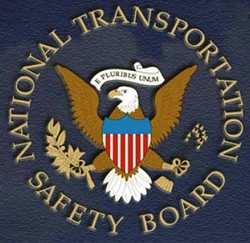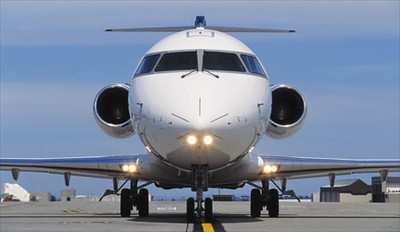Tue, Nov 21, 2006
 The National
Transportation Safety Board issued a list of safety recommendations
Monday affecting operators of Bombardier CL600-series regional jets
and corporate aircraft.
The National
Transportation Safety Board issued a list of safety recommendations
Monday affecting operators of Bombardier CL600-series regional jets
and corporate aircraft.
In its letter to the FAA, the NTSB recommends the agency require
manufacturers of airplanes equipped with General Electric CF34-1 or
CF34-3 engines to adopt a standard procedure to handle high-power,
high-altitude sudden engine shutdowns... as well as a procedure to
restart those engines after such an event.
The Board also recommends manufacturers of other turbofan
engines review their designs, to see if their powerplants are
susceptible to similar cases of "core lock" the NTSB says
contributed to the loss of a Pinnacle Airlines regional jet in
2004.
In that accident, two pilots ferrying a CRJ200 were
killed after they flew the plane on a "joyride" up to
41,000 feet, and experienced an aerodynamic stall. The disturbed
airflow caused the engines to flame out... and the pilots were
unable to get them restarted.
Below are the recommendations sent to the FAA:
- For airplanes equipped with CF34-1 or CF34-3 engines, require
manufacturers to perform high power, high altitude sudden engine
shutdowns; determine the minimum airspeed required to maintain
sufficient core rotation; and demonstrate that all methods of
in-flight restart can be accomplished when this airspeed is
maintained. (A-06-70)
- Ensure that airplane flight manuals of airplanes equipped with
CF34-1 or CF34-3 engines clearly state the minimum airspeed
required for engine core rotation and that, if this airspeed is not
maintained after a high power, high altitude sudden engine
shutdown, a loss of in-flight restart capability as a result of
core lock may occur. (A-06-71)
- Require that operators of CRJ-100, -200, and -440 airplanes
include in airplane flight manuals the significant performance
penalties, such as loss of glide distance and increased descent
rate, that can be incurred from maintaining the minimum airspeed
required for core rotation and windmill restart attempts.
(A-06-72)
- Review the design of turbine-powered engines (other than the
CF34-1 and CF34-3, which are addressed in Safety Recommendation
A-06-70) to determine whether they are susceptible to core lock
and, for those engines so identified, require manufacturers of
airplanes equipped with these engines to perform high power, high
altitude sudden engine shutdowns and determine the minimum airspeed
to maintain sufficient core rotation so that all methods of
in-flight restart can be accomplished. (A-06-73)

- For those airplanes with engines that are found to be
susceptible to core lock (other than the CF34-1 and CF34-3, which
are addressed in Safety Recommendation A-06-71), require airplane
manufacturers to incorporate information into airplane flight
manuals that clearly states the potential for core lock; the
procedures, including the minimum airspeed required, to prevent
this condition from occurring after a sudden engine shutdown; and
the resulting loss of in-flight restart capability if this
condition were to occur. (A-06-74)
- Require manufacturers to determine, as part of 14 Code of
Federal Regulations Part 25 certification tests, if restart
capability exists from a core rotation speed of 0 indicated rpm
after high power, high altitude sudden engine shutdowns. For those
airplanes determined to be susceptible to core lock, mitigate the
hazard by providing design or operational means to ensure restart
capability. (A-06-75)
- Establish certification requirements that would place upper
limits on the value of the minimum airspeed required and the amount
of altitude loss permitted for windmill restarts. (A-06-76)
More News
Terminal Radar Service Area Airspace surrounding designated airports wherein ATC provides radar vectoring, sequencing, and separation on a full-time basis for all IFR and participa>[...]
Aero Linx: Utah Back Country Pilots Association (UBCP) Through the sharing experiences, the UBCP has built upon a foundation of safe operating practices in some of the most challen>[...]
From 2010 (YouTube Edition): Imagine... Be The Change... Inspire FROM 2010: One of the more unusual phone calls I have ever received occurred a few years ago... from Anousheh Ansar>[...]
(Pilot) Felt A Shudder And Heard The Engine Sounding Differently, Followed By The Engine Chip Detector Light On April 14, 2025, about 1800 Pacific daylight time, a Bell 206B, N1667>[...]
Also: AMA Names Tyler Dobbs, More Falcon 9 Ops, Firefly Launch Unsuccessful, Autonomous F-16s The Air Force has begun ground testing a future uncrewed jet design in a milestone tow>[...]
 ANN's Daily Aero-Term (05.07.25): Terminal Radar Service Area
ANN's Daily Aero-Term (05.07.25): Terminal Radar Service Area ANN's Daily Aero-Linx (05.07.25)
ANN's Daily Aero-Linx (05.07.25) Classic Aero-TV: Anousheh Ansari -- The Woman Behind The Prize
Classic Aero-TV: Anousheh Ansari -- The Woman Behind The Prize NTSB Prelim: Bell 206B
NTSB Prelim: Bell 206B Airborne-NextGen 05.06.25: AF Uncrewed Fighters, Drones v Planes, Joby Crew Test
Airborne-NextGen 05.06.25: AF Uncrewed Fighters, Drones v Planes, Joby Crew Test




